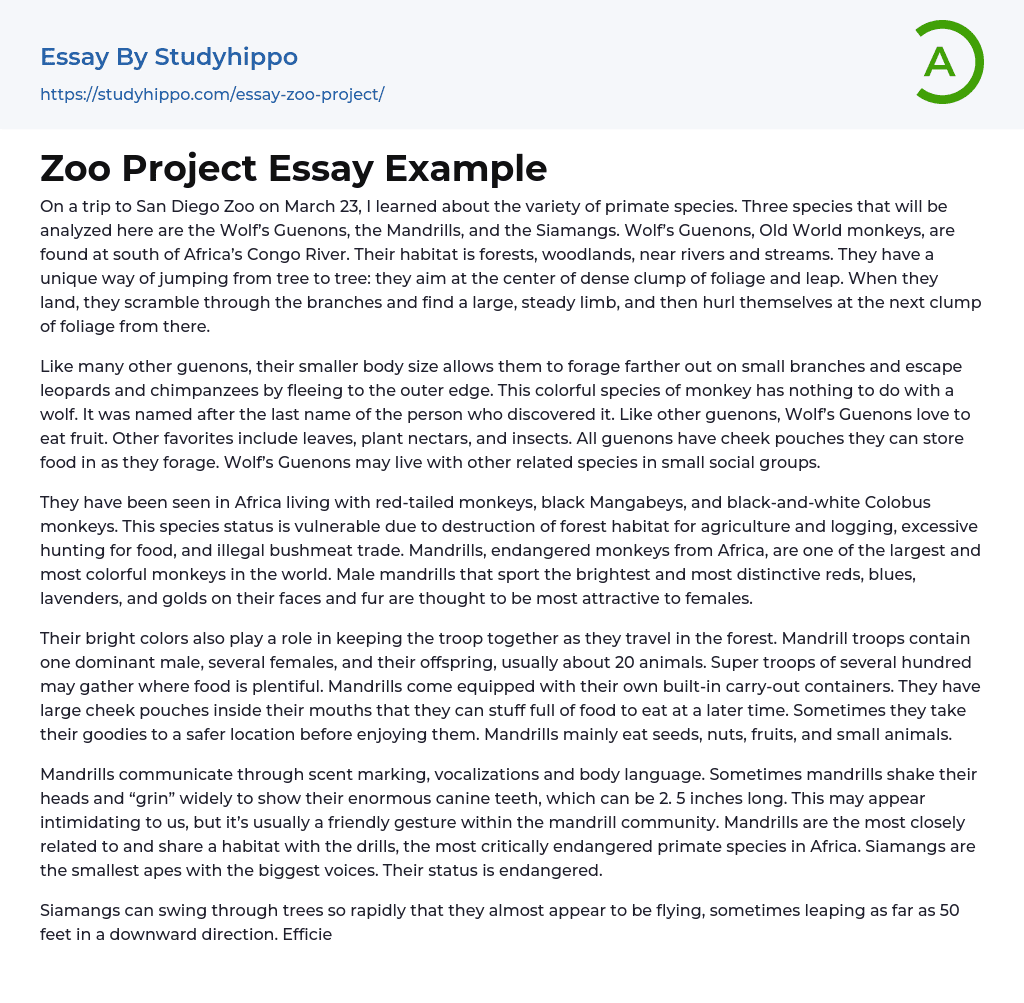On a trip to San Diego Zoo on March 23, I learned about the variety of primate species. Three species that will be analyzed here are the Wolf’s Guenons, the Mandrills, and the Siamangs. Wolf’s Guenons, Old World monkeys, are found at south of Africa’s Congo River. Their habitat is forests, woodlands, near rivers and streams. They have a unique way of jumping from tree to tree: they aim at the center of dense clump of foliage and leap. When they land, they scramble through the branches and find a large, steady limb, and then hurl themselves at the next clump of foliage from there.
Like many other guenons, their smaller body size allows them to forage farther out on small branches and escape leopards and chimpanzees by fleeing to the outer edge. This colorful species of monkey has no
...thing to do with a wolf. It was named after the last name of the person who discovered it. Like other guenons, Wolf’s Guenons love to eat fruit. Other favorites include leaves, plant nectars, and insects. All guenons have cheek pouches they can store food in as they forage. Wolf’s Guenons may live with other related species in small social groups.
They have been seen in Africa living with red-tailed monkeys, black Mangabeys, and black-and-white Colobus monkeys. This species status is vulnerable due to destruction of forest habitat for agriculture and logging, excessive hunting for food, and illegal bushmeat trade. Mandrills, endangered monkeys from Africa, are one of the largest and most colorful monkeys in the world. Male mandrills that sport the brightest and most distinctive reds, blues, lavenders, and golds on
their faces and fur are thought to be most attractive to females.
Their bright colors also play a role in keeping the troop together as they travel in the forest. Mandrill troops contain one dominant male, several females, and their offspring, usually about 20 animals. Super troops of several hundred may gather where food is plentiful. Mandrills come equipped with their own built-in carry-out containers. They have large cheek pouches inside their mouths that they can stuff full of food to eat at a later time. Sometimes they take their goodies to a safer location before enjoying them. Mandrills mainly eat seeds, nuts, fruits, and small animals.
Mandrills communicate through scent marking, vocalizations and body language. Sometimes mandrills shake their heads and “grin” widely to show their enormous canine teeth, which can be 2. 5 inches long. This may appear intimidating to us, but it’s usually a friendly gesture within the mandrill community. Mandrills are the most closely related to and share a habitat with the drills, the most critically endangered primate species in Africa. Siamangs are the smallest apes with the biggest voices. Their status is endangered.
Siamangs can swing through trees so rapidly that they almost appear to be flying, sometimes leaping as far as 50 feet in a downward direction. Efficient and graceful in the trees, they are awkward on the ground. Rather than building nests, Siamangs sleep upright in tree foliage. Siamangs weigh between 17 and 28 pounds and are superbly adapted for life in the trees. They move between the trees by swinging from branch to branch by their long, hooked-fingered hands. Their jet black coat is
heavy, shaggy fur. The face is naked except for scattered and sparse stubble of moustache and beard.
Siamangs spend almost all of their time high in the forest canopies of Sumatra and mainland Malaysia. Siamangs are omnivores and feed on fruits (especially figs), buds, foliage, flowers, insects, spiders, small lizards, birds and bird eggs. At the Zoo, the Siamangs are fed a diet of bread, cooked sweet potatos, bananas, apples, oranges and lettuce. The basic Siamang social group is a family made up of one male, one female, and as many as four of their young. Within each family, food is generously shared and fighting rarely occurs. Members of the same family will drive off strangers.
Grooming is the most important social behavior. Siamangs are monogamous, and display an unusually high level of parental care. At about one year of age, the adult male takes over most of the daily care of the young. But the prolonged maternal care of infants by the mother may last as long as 20 months. There were three Siamangs doing three different things. Two of them spent most of their time grooming to each other while the third one swang from tree to tree, walked for a little bit than took rest. He used a branch of a large tree, lying on his back then rolled over to his stomach, enjoying a nice, peaceful day.
- Rabbit essays
- Distribution essays
- Large Animals essays
- Mouse essays
- Poultry essays
- Animal Abuse essays
- Cats Vs Dogs essays
- Cattle essays
- Territory essays
- Microbiology essays
- Bacteria essays
- Cell essays
- Enzyme essays
- Photosynthesis essays
- Plant essays
- Natural Selection essays
- Protein essays
- Viruses essays
- Cell Membrane essays
- Human essays
- Stem Cell essays
- Breeding essays
- Biotechnology essays
- Cystic Fibrosis essays
- Tree essays
- Seed essays
- Coronavirus essays
- Zika Virus essays
- Agriculture essays
- Albert einstein essays
- Animals essays
- Archaeology essays
- Bear essays
- Biology essays
- Birds essays
- Butterfly essays
- Cat essays
- Charles Darwin essays
- Chemistry essays
- Dinosaur essays
- Discovery essays
- Dolphin essays
- Elephant essays
- Eli Whitney essays
- Environmental Science essays
- Evolution essays
- Fish essays
- Genetics essays
- Horse essays
- Human Evolution essays




